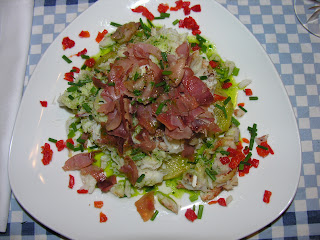 In some parts of the country, fresh sweet corn is already available. Not quite here in Minnesota, but it’s close. This very easy recipe would be fine in the middle of winter with frozen corn, but if you can get fresh corn, it’s a nice change from corn on the cob - not that there are many foods better than that. The amounts indicated are for a pound of pasta. I used rotini, but if one likes the symmetry or the theme of small corn kernels, one could use orzo or ditalini.
In some parts of the country, fresh sweet corn is already available. Not quite here in Minnesota, but it’s close. This very easy recipe would be fine in the middle of winter with frozen corn, but if you can get fresh corn, it’s a nice change from corn on the cob - not that there are many foods better than that. The amounts indicated are for a pound of pasta. I used rotini, but if one likes the symmetry or the theme of small corn kernels, one could use orzo or ditalini.
Fresh corn, 3 ears, kernels removed
One yellow bell pepper, cut roughly the size of corn kernels
Garlic, two cloves, crushed
White pepper
Light cream, 2 cups
Vermouth or white wine
Scallions, minced
Minced pimientos, I small jar, drained
Salt
Butter, 1-2 Tbs
Asiago cheese, grated, a cup or more
Pasta
Reserve one cup of the corn kernels and a cup or less of the yellow bell pepper, depending on the size. Place the remaining corn and bell pepper in a saucepan, along with the light cream, garlic, and pepper, and bring to a boil. Remove from the heat and carefully pour into a blender. Puree. Return to the saucepan and add the pimientos, scallions, and vermouth or white wine. Bring to a boil, then turn down the heat and allow to simmer for a few minutes to thicken slightly. Add some salt. In a separate skillet, melt the butter and quickly saute the reserved corn kernels and the reserved pieces of yellow bell pepper until a bit charred.
In the meantime, cook the pasta. Drain and return to the pot. Add the creamed corn mixture. Plate and add the sauteed corn and bell pepper, finishing with the cheese.










